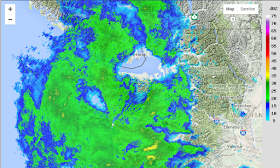I've mentioned how the Olympic Mountain rain shadow has such a profound impact on Victoria's climate. Thanks to this effect, the Victoria Gonzales weather station averages only 641 mm of precipitation annually, compared more than 1000 mm in Metchosin (20 km west) and more than 3500 mm at Port Renfrew (80 km west on the exposed southwest coast of Vancouver Island).
Yesterday, we had a good example of a rain shadow. Here's what the radar looked like around midday yesterday:
You can see there is a pretty clear hole in the rain over Victoria, as well as the northeast Olympic Peninsula. That "hole" persisted for most of the day and there were only a couple of light sprinkles. Meanwhile, there was steady rain all day up at the Victoria Airport, with rain recorded every hour from 4 am until midnight yesterday.
The precipitation totals from yesterday also tell the story. There was just 1.4 mm of rain at Victoria Gonzales and 1.5 mm of rain at the University of Victoria weather station. At the Esquimalt weather station, about 8 km west of Gonzales, there was 5 mm of rain. At the Victoria Airport, 25 km north of Victoria, there was more than 14 mm of rain - ten times the amount that fell at Gonzales. Rainfall totals at up-Island locations were even higher: 26 mm in Duncan, 24 mm in Nanaimo and 28 mm in Campbell River.
The rain shadow tends to be centered over the eastern part of the Strait of Juan de Fuca, as shown in the map below from the informative website OlympicRainShadow.com.
Sequim and Port Townsend, Washington, which are located closest to the center, feel the greatest impact from the rain shadow. Port Townsend averages only 484 mm of annual precipitation, while Sequim receives a mere 407 mm. A little further west, Port Angeles averages 642 mm - roughly the same as Victoria Gonzales. The rain shadow area is not static; it tends to wobble around, so sometimes Victoria is in the rain shadow while other times it is just off to our southeast. Because Victoria is on the northwestern edge of the rain shadow, areas immediately to our west and north see little or no impact from it (although areas to the north, including the Victoria Airport and the Gulf Islands, do benefit from the less potent rain shadow produced by the lower Vancouver Island mountains).
The Victoria Gonzales weather station is located in that part of the Victoria region that is most impacted by the rain shadow. Interestingly, the Victoria School-Based Weather Station Network opened a weather station on Trial Island in 2013. Trial Island is located off the south coast of Oak Bay, about 2 km southeast of Victoria Gonzales, so it is the piece of land in the Victoria Region that is closest to the rain shadow. Annual data for 2014 and 2015 show that the Trial Island station received only about 400 mm of rain in each of these years, substantially lower than Gonzales. I'm not sure how accurate these measurements are, and I suspect they may underestimate the rainfall at Trial Island somewhat, but it is likely that the Trial Island weather station occupies the driest site measured on the British Columbia coast, a title long held by Victoria Gonzales.


As most everyone already knows, we did not always have scientific means to predict or forecast the coming weather. People long ago and even today use the other things to predict the weather; animals behavior, patterns they observe and good old fashion folklore and wives tales.Owen
ReplyDelete